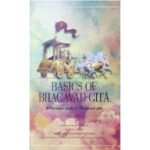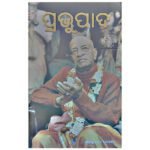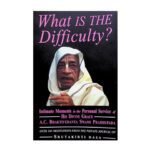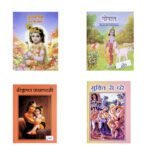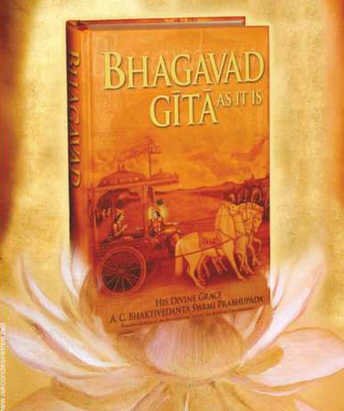sarvo ‘panishado gaavo dogdhaa gopaala nandanaha
paartho vatsah sudhir bhoktaa dugdham gitaa ‘mrtam mahat
All the Upanishads are like the cows; the one who milks them is Krishna, the cowherd boy; Arjuna is the calf; and men who are wise and pure drink the milk, which is the supreme, immortal nectar of the Gita.
The Bhagavad Gita is a battlefield conversation between two friends, Lord Shri Krishna and Arjuna. Keeping Arjuna in context The Supreme Lord Krishna is addressing all of us, the Bhagavad Gita is a renowned jewel of our spiritual wisdom. Although widely published and read by itself, Bhagavad Gita originally appears as an episode in the Mahabharata, the epic Sanskrit history of the ancient world. It was the beginning of this age, some fifty centuries ago, that Lord Krishna spoke Bhagavad Gita to his friend and devotee Arjuna. Lord Krishna is both the goal and the substance of the Bhagavad Gita.
ekaṁ śāstraṁ devakī-putra-gītam
eko devo devakī-putra eva
eko mantras tasya nāmāni yāni
karmāpy ekaṁ tasya devasya sevā (Gita-mahatmaya 7)
In this present day, people are very much eager to have one scripture, one God, one religion and one occupation. Therefore, ekam sastram Devaki-putra-gitam; let there be one scripture only, one common scripture for the whole world-Bhagavad-gita. Eko devo Devaki putra eva: let there be one God for the whole world-Shri Krishna. Eko mantras tasya namani: and one hymn, one mantra, one prayer- the chanting of his name. HARE KRSNA HARE KRSNA KRSNA KRSNA HARE HARE HARE RAMA HARE RAMA RAMA RAMA HARE HARE. Karmapy ekam tasya devasya seva: and let there be one work only- the service of the Supreme Personality of Godhead.
The ultimate wealth in one’s life is that which can bring us real, lasting, eternal, undying, endless happiness- that is what the Bhagavad Gita is all about! There are many messages that Krsna gives throughout the Bhagavad Gita, but the message of love and devotion stands out bright. The essence of Bhagavad Gita is devotional service to Lord Krishna. In the Bhagavad Gita we are told that we are not these bodies or the mind or the intelligence. We are eternal spiritual sparks, spiritual souls. Real happiness, real success lies in identifying ourselves as spiritual entities and we are not just meant to be here just to be satisfied with some trifling pleasures and momentary successes of this world. We are a spiritual entity and our goals are very high. We are meant to be free. When we understand the philosophy of the Bhagavad Gita, we will see a major transformation in our life. The Bhagavad Gita has influenced many people throughout the world such as influential personalities like honourable Prime Minister of India Shri Narendra Modi, Will Smith, Sunita Williams, Jawahar Lal Nehru, Henry David Thoreau and so on.
The Bhagavad Gita has 18 chapters in total and 700 Sanskrit shlokas and verses.
Chapter One:
Observing the Armies on the Battlefield of Kuruksetra
As the opposing armies stand poised for battle, Arjuna the mighty warrior, sees his intimate relatives, teachers and friends in both armies ready to fight and sacrifice their lives. Overcome by grief and pity, Arjuna fails in strength, his mind becomes bewildered, and he gives up his determination to fight.
Chapter Two:
Contents of the Gita Summarized
Arjuna submits to Lord Krishna as his disciple, and Krishna begins His teachings to Arjuna by explaining the fundamental distinction between the temporary material body and the eternal spiritual soul. The Lord explains the process of transmigration, the nature of selfless service to the Supreme and the characterstics of a self- realised person.
Chapter Three:
Karma-Yoga
Everyone must engage in some sort of activity in this material world. But actions can either bind one to this world or liberate one from it. By acting for the pleasure of the Supreme, without selfish motives, one can be liberated from the law of karma (action and reaction) and attain transcendental knowledge of the self and the Supreme.
Chapter Four:
Transcendental Knowledge
Transcendental Knowledge- the spiritual knowledge of the soul, of God, and of their relationship- is both purifying and liberating. Such knowledge is the fruit of selfless devotional action (karma-yoga). The Lord explains the remote history of the Gita, the purpose and significance of his periodic descents to the material world, and the necessity of approaching a guru, a realised teacher.
Chapter Five:
Karma-Yoga, Action in Krishna Consciousness
Outwardly performing all actions but inwardly renouncing their fruits, the wise man, purified by the fire of transcendental knowledge, attains peace, detachment, forbearance, spiritual vision and bliss.
Chapter Six:
Dhyana-Yoga
Astanga-Yoga a mechanical meditative practice, controls the mind and senses and focuses concentration on the Paramatma (the Supersoul, the form of the Lord situated in the heart.) This practice culminated in samadhi, full consciousness of the Supreme.
Chapter Seven:
Knowledge of the Absolute
Lord Krishna is the Supreme Truth, the supreme cause and sustaining force of everything, both material and spiritual. Advanced souls surrender unto him in devotion, whereas impious souls divert minds to other objects of worship.
Chapter Eight:
Attaining the Supreme
By remembering Lord Krishna in devotion throughout one’s life and especially at the time of death, one can attain to His supreme abode, beyond the material world.
Chapter Nine:
The Most Confidential Knowledge
Lord Krishna is the Supreme Godhead and the supreme object of worship. The soul is eternally related to Him through transcendental devotional service (bhakti). By reviving one’s pure devotion one returns to Krishna in the spiritual realm.
Chapter Ten:
The Opulence of the Absolute
All wondrous phenomena showing power, beauty, grandeur or sublimity, either in the material world or in the spiritual, are but partial manifestations of Krishna’s divine energies and opulence. As the supreme cause of all causes and the support and essence of everything, Krishna is the Supreme object of worship for all beings.
Chapter Eleven:
The Universal Form
Lord Krishna grants Arjuna divine vision and reveals His spectacular unlimited form as the cosmic universe. Thus, He conclusively establishes His divinity. Krishna explains that his own all-beautiful humanlike form is the original form of Godhead. One can perceive this form only by pure devotional service.
Chapter Twelve:
Devotional Service
Bhakti-Yoga, pure devotional service to Lord Krishna, is the highest and most expedient means for attaining pure love for Krishna, which is the highest end of spiritual existence. Those who follow this supreme path develop divine qualities.
Chapter Thirteen:
Nature, the Enjoyer and Consciousness
One who understands the difference between the body, the soul and the Super-soul beyond them both attains liberation from this material world.
Chapter Fourteen:
The Three Modes of Material Nature
All embodied souls are under the control of the three modes, or qualities, of material nature: goodness, passion and ignorance. Lord Krishna explains what these modes are, how they act upon us, how one transcends them, and the symptoms of one who has attained the transcendental state.
Chapter Fifteen:
The Yoga of the Supreme Person
The ultimate purpose of Vedic knowledge is to detach oneself from the entanglement of the material world and to understand Lord Krishna as the Supreme Personality of Godhead. One who understands Krishna’s supreme identity surrenders unto Him and engages in His devotional service.
Chapter Sixteen:
The Divine and Demoniac Natures
Those who possess demoniac qualities and who live whimsically, without following the regulations of scripture, attain lower births and further material bondage. But those who possess divine qualities and live regulated lives, abiding by scriptural authority, gradually attain spiritual perfection.
Chapter Seventeen:
The Divisions of Faith
There are three types of faith, corresponding to and evolving from the three modes of material nature. Acts performed by those whose faith is in passion and ignorance yield only impermanent, material results, whereas acts performed in goodness, in accord with scriptural injunctions, purify the heart and lead to pure faith in Lord Krishna and devotion to Him.
Chapter Eighteen: Conclusion-
The Perfection of Renunciation
Krishna explains the meaning of renunciation and the effects of the modes of nature on human consciousness and activity. He explains Brahman realisation, the glories of the Bhagavad Gita; and the ultimate conclusion of the Gita: the highest path of religion is absolute, unconditional loving surrender unto Lord Krishna, which frees one from all sins, brings one to complete enlightenment, and enables one to return to Krishna’s eternal spiritual abode.


 Accessories
Accessories
